Oakland Post
Pallbearers
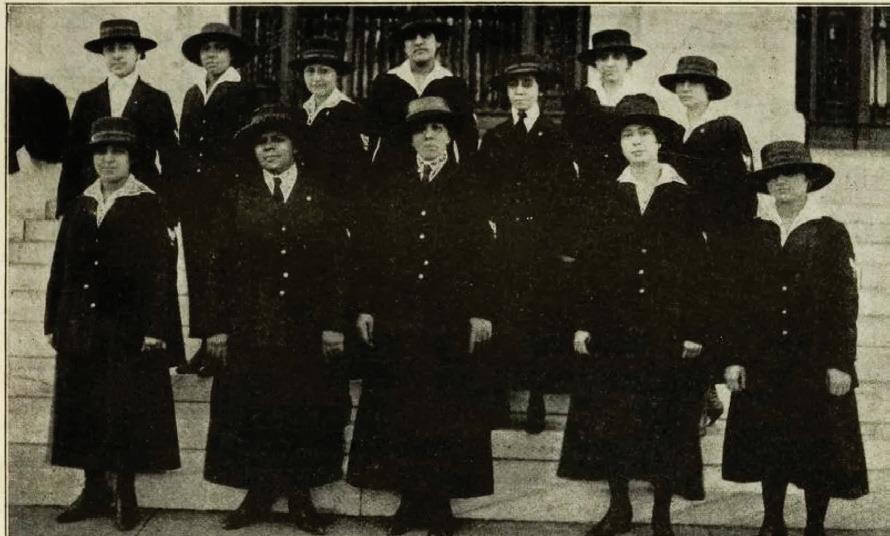
Promoting community participation, James Vann, a longtime Oakland advocate for tenants’ rights and for humane homelessness policies, said he hopes to see people stepping up to work with Thao’s administration.
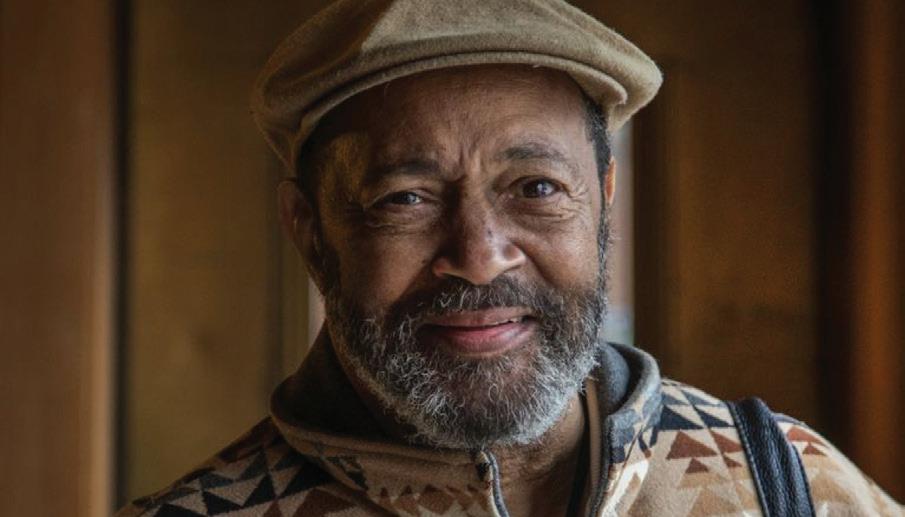
“There are many openings on boards and commissions, and there will be opportunities for people to help make positive changes in Oakland,” said Vann.
Added LaNiece Jones of Black Women Organized for Political Action (BWOPA).:

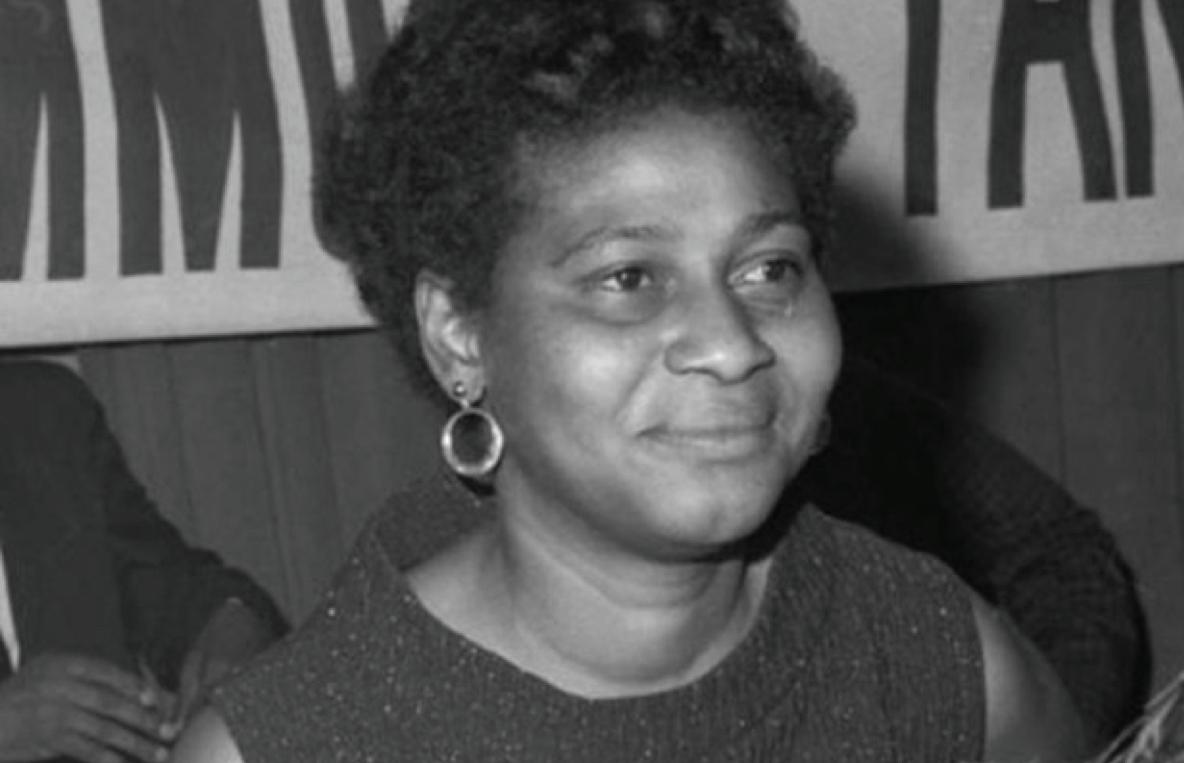
Acknowledgements
large with our new administration via the numerous boards and commission opportunities available. Let’s go!”
“It’s a chance for our people who have not had an opportunity to be part of decision making to be at the table,” she said.
At present, some of the nearly 40 boards and commissions are almost dormant, and others have a narrow range of members mostly allied with the outgoing mayor’s pro-corporate development agenda. The list includes:
• City Planning Commission (2 vacancies)
• Commission on Homelessness (7 vacancies)
• Oakland Youth Commission (2 vacancies)
• Cultural Affairs Commission (5 vacancies)
• Parks and Recreation Advisory Commission (1 vacancy)
• Police Commission (2 vacan-
cision,” he said.
Celebrating the Life of
Pamela Drake, who is a member of the Wellstone Democratic Club and is active in the Democratic Party said, “We have a lot of commissions and boards, but under Libby, anyone who had influence was part of an inside clique. She left us in a state of dysfunction.”
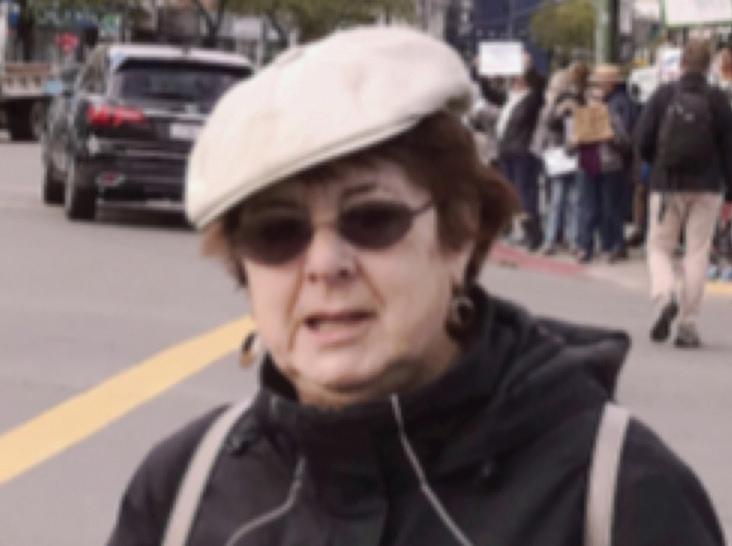
“To me, it’s most important that people are involved in local government,” she said. “They need to be involved in making decisions. At the level of commissions, they can actually make policy.”
Joe L. Hudson Deacon
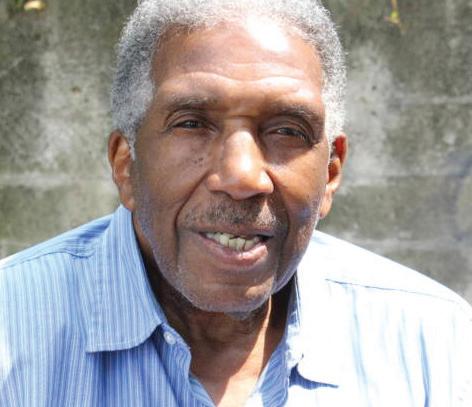
FRIDAY, DECEMBER 23, 2022
FUNERAL: 11:00 AM PIONEER MISSIONARY BAPTIST CHURCH 315 E. 161st Place South Holland, IL 60473 Dr. Preston Winfrey, Officiating
where he first found his passion with auto mechanics. Joe also enjoyed playing basketball.
As a young teenager in Greenwood, Mississippi Joe met and fell in love with Lucille Green. Their love was fierce, and they cemented their union with marriage on November 27, 1954.
Like many Black families before them, in the fifties the newlyweds crossed the Mason Dixon Line to Chicago in pursuit of a better life for their budding family. From their union were born 4 daughters Brenda, Doris, Renia, and Linda. He also has a daughter Beverly Ann Harris.
Once they migrated to Chicago, Joe and his family joined the historic Stone Temple M.B. Church on the west side under the leadership of Rev. James Marcellus Stone. He began working at Supreme Products where he worked

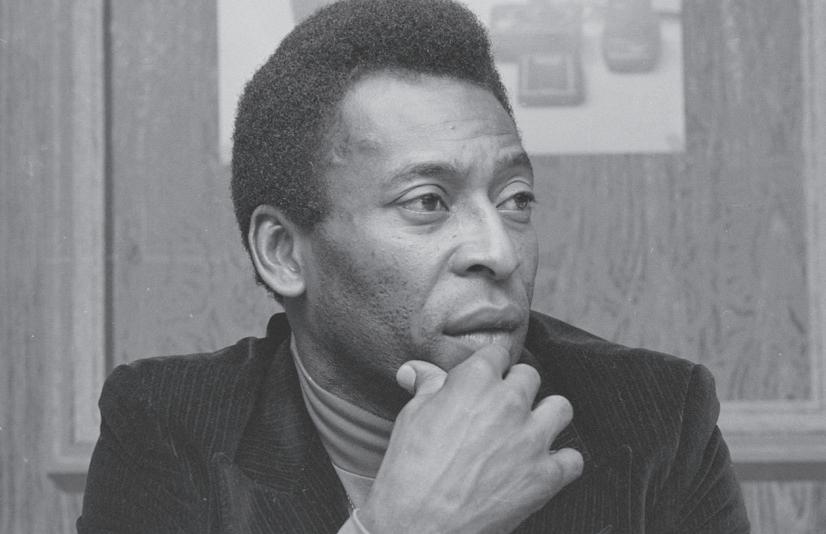
Post Publisher in Selma March with Dr. King
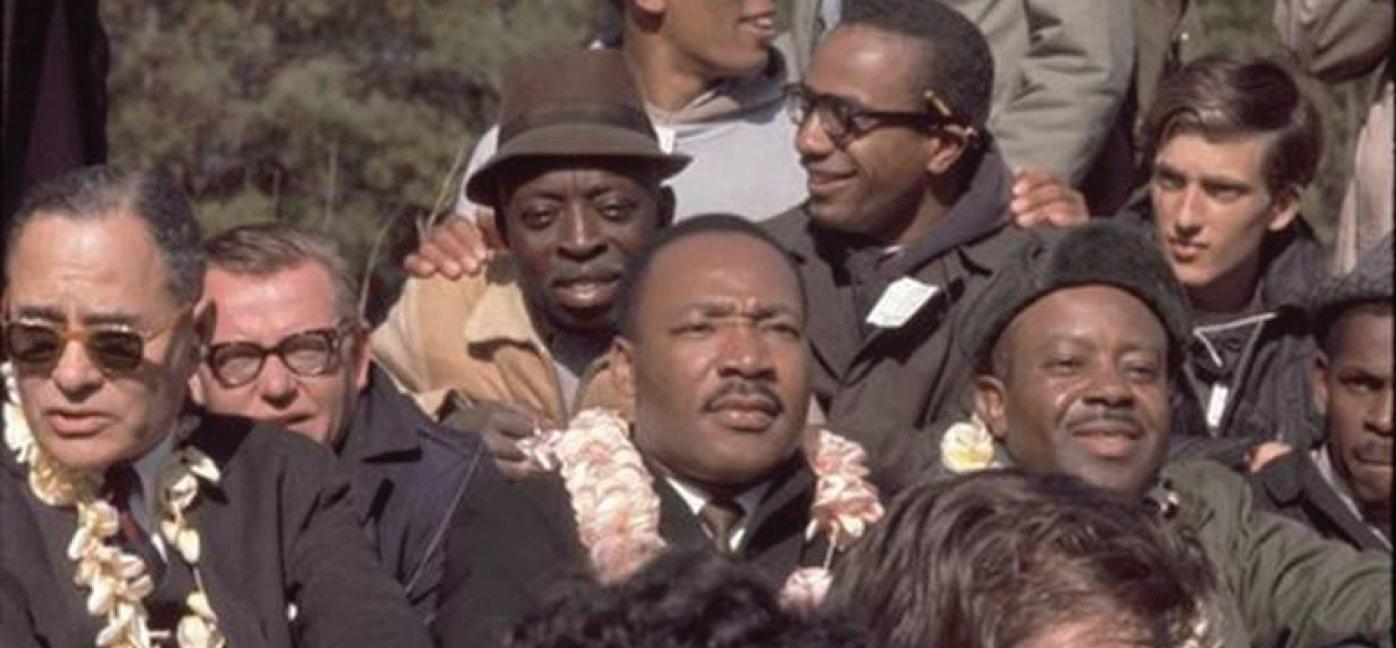
was very proud of the work that he did and the legacy he left behind there. Joe was adored and mentored many during his time there.
In 1972 Joe and his family joined Pioneer Baptist Church under the leadership of Rev. James Butler. Rev. Preston R. Winfrey became the pastor in 1981 after the resignation of Rev. Butler. Joe remained a devoted member of Pioneer until his passing. Joe served in many roles for the church faithfully, but his most prized role was that of a Deacon. He served on the Deacon Board, Trustees Board, Department of Christian Service, Male Chorus, he was the Superintendent of Sunday School, a member of the Christian Education, Sunday School Teacher, and Zone Deacon. While at Pioneer he attended Moody Bible Institute to further his biblical training and leadership. He loved his church,
exceptional work-ethic. He loved his wife Lucille dearly. Joe leaves a legacy of dedication, independence, and perseverance for all to follow.
After serving the Lord through sickness and health, Joe’s Savior invited him from labor to reward. Being surrounded by his family, and listening to a recorded worship service of his church family, Joe quietly bid his family farewell, and said hello to his loving heavenly father. Joe leaves to cherish his memory, his wife Lucille and their daughters Brenda, Doris (Mark Sr.), Renia, and Linda, his daughter Beverly Ann Harris, foster children Antwan and Tanya Sneed, his sisters Rosie B. Jackson, Virginia Pulliam, and Annette McCann, a host of grandchildren, great grandchildren, nieces, nephews, and God children.
Artist, 7, Draws MLK’s image as her call for peace
 By Paul and Gay Plair Cobb
By Paul and Gay Plair Cobb
I will be publishing a series of articles about our participation and how the meaning of the Selma to Montgomery, Alabama journey helped to shape and influence my
life and my journalistic and professional career.
In 1965 a multi-racial group of four young men from Oakland went to Selma Alabama to march with
The Southern Christian Lead-

ership

the Late Rev. Dr. Martin Luther King, Jr. took a stand to demand the right to vote for all Americans. Our group consisted of Milton Hare, Caucasian, Fernando Canales, Latino,
Shiloh Plair-Jones a 7 year-old artist said she drew a picture of Dr. Martin Luther King, Jr. after seeing a video of him talking during her first-grade class. Shiloh said, “I saw a picture of Martin Luther King and I miss him because if he was here we wouldn’t have all these problems in New York City and everywhere.”
Shiloh’s mother Jill said, “She also hears what her grandparents Ted and Therese Plair discuss when they are watching the news and talking about the world’s problems.” During her interview with the Post, Shiloh said she drew Dr. King because “He was a good guy. He made the Black and White kids be able to go to school together and not be apart .
‘
‘
3
Forgotten Bladk Women Who Served in WWI...Page
Soccer Legend, Pele... Page 5
Honoring Charlene Mitchell... Page 10
The Sound of Philadelphia Thom Bell.. Page 5
James Vann. Photo courtesy of James Vann. Pamela Drake. Photo courtesy of Pamela Drake.
By Paul Lawrence Cobb, Religion Editor Oakland Post
Every year we celebrate the national holiday of the January 15th birthday of the Rev. Dr. Martin Luther and honor him for his sac-
rifices to end voter suppression and voter exclusion for Blacks.
Conference led by
Continued on page 10
Jill Plair and her daughter Shiloh Plair-Jones
Thank you for the love and support that has been bestowed upon our family during this time. We thank you for your prayers, phone calls, beautiful flowers, comforting words, and thoughtful cards. Thank you to Dr. Preston R. Winfrey, Pastor and the entire Pioneer Missionary Baptist Church family for covering our family during our time of grief.
April 16, 1936 - December 14, 2022
The Hudson Family
Designed & Printed By Abbott’s Printing, Inc. 611 E. 170th Street • South Holland, IL 60473 • 708.339.6010
Mark E. Dawson Jr.
Mario Louis Dawson
Lawrence Joseph Gayden
Joshua Daniel Hudson Antwan Sneed
Christopher Hudson Onome O’Gude
Damilola Gbadebo
Gov. Newsom’s Broadband Initiative Brings Access Statewide to Digitally Disadvantaged
By Aldon Thomas Stiles California Black Media
In October, Gov. Gavin Newsom held a press conference in San Diego County to announce that the construction of the Middle-Mile Broadband Initiative had commenced.
A collaboration between California’s Department of Transportation (Caltrans) and the Department of Technology, the initiative’s purpose is to construct a
“We live in this whole space around the most digitally disadvantaged, which are often the most economically disadvantaged,” said McPeak. “That persistent concentrated poverty is all rooted in systemic racism.”
Communities of color have slightly less broadband access than white communities. While 17% of Black households are without access to internet, 13% of white households lack access, according to data from the U.S. Census Bureau’s 2020 American Community Survey (ACS).
“Beginning construction on the Middle-Mile network is a significant step toward broadband equity and providing all Californians the opportunity to access critical information,” Secretary of the California Transportation Agency Toks Omishakin said in a press release.
“High-speed internet is much more than a connection – it’s a lifeline that families need to work, learn, and access critical services,” Omishakin continued.
Sonya Aadam: CEO of California Black Women’s Health Project
By Edward Henderson/ California Black Media
Sonya Aadam is chief executive officer of California Black Women’s Health Project. Founded in 1992, the organization says its mission is to improve the health of California’s 1.2 million Black women and girls through advocacy, education, outreach and policy change.
A South Los Angeles native, Aadam’s work includes mentoring and preparing women to navigate a healthcare system that has notoriously underserved Black women.
California Black Media asked Aadam to reflect on the past year and share her plans for 2023.
CBM: With the work you do advocating for African Americans in California, what was your biggest accomplishment in 2022?
years of funding from the California Dept. of Public Health.
CBM: What did you find most challenging over the past year?

S.A. Persistent limitations in funding for our work remains our greatest challenge because it means lower wages for existing staff, difficulty attracting new staff, and constant pressure to do more with less.
Our dedicated team could make considerably more in salary elsewhere, but they are willing to sacrifice higher earnings because they believe deeply in the work that we do to uplift better health and wellness for Black women, girls, families, and communities.
As the CEO of this organization, this lack of sufficient resources is a major source of stress.

CBM: What are you most looking forward to in 2023?
ty capacity, and empower our sisters statewide to guard their health and wellness.
CBM: What’s the biggest challenge Black Californians will face next year?
S.A. The COVID-19 pandemic continues to wreak havoc on the health and wellness of Black Californians. We consistently worry about the ongoing mental and emotional strain, what we refer to as “Post-COVID-StressDisorder.”
The fallout of the pandemic and ongoing challenges in securing recovery funding and support will challenge us and require organizations like ours to work harder, go deeper, and fight harder to fill gaps and advocate for mental health and other services.
The
of last year.
“California is now one step closer to making the digital divide a thing of the past,” said Newsom. “This is about ensuring that all Californians, no matter the zip code they call home, can be part of the Golden State’s thriving and diverse economy.”
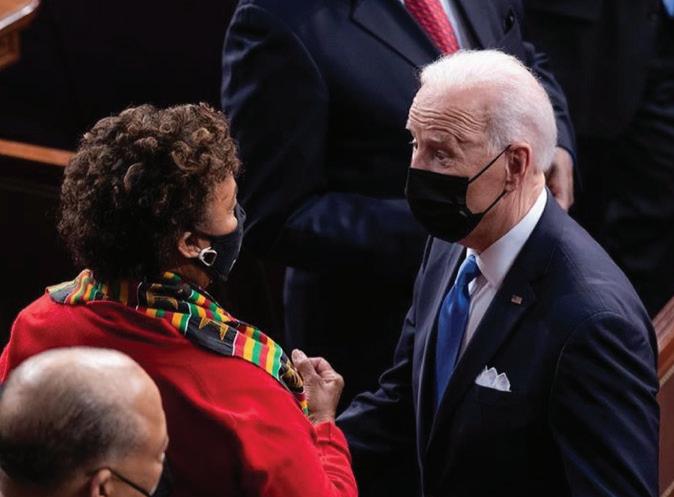
Once the network has been constructed, the state will provide funding for “last mile” efforts which refers to infrastructure that connects the network to “end-use” entities such as homes and businesses.

The Middle-Mile Initiative boasts a $6.5 billion budget to extend and improve internet access for “unserved and underserved communities” such as Indigenous American reservations, some low-income neighborhoods, and rural areas.

“So, I really want to underscore that our stance on digital equity is that it’s a 21st century civil right,” Sunne Wright McPeak, president and CEO of the California Emerging Technology Fund (CETF), told California Black Media (CBM).

CETF is a nonprofit committed to closing the digital divide. It is the only non-state agency serving on the California Broadband Council which identifies and deploys resources for internet access.

McPeak asserts that high poverty urban areas are hard to reach and suggests that broadband infrastructure often neglects these neighborhoods.
Another piece of the puzzle is the private sector, California State Superintendent of Public Instruction Tony Thurmond told CBM.
“And because of the way internet service providers and other companies have tried to capitalize on the internet, that means that the U.S. has communities that have been without access to the internet for a long time, even though there’s so much resourcing available,” Thurmond said.
McPeak echoed the assessment and suggested how state officials can convince private companies to aid in providing open access for Californians by providing incentives to do so.
“One thing the state could do to get much more cooperation is what I call ‘step up or step aside,’” said McPeak. “And that would be powerful if there was that kind of bold leadership that’s on the deployment side.”
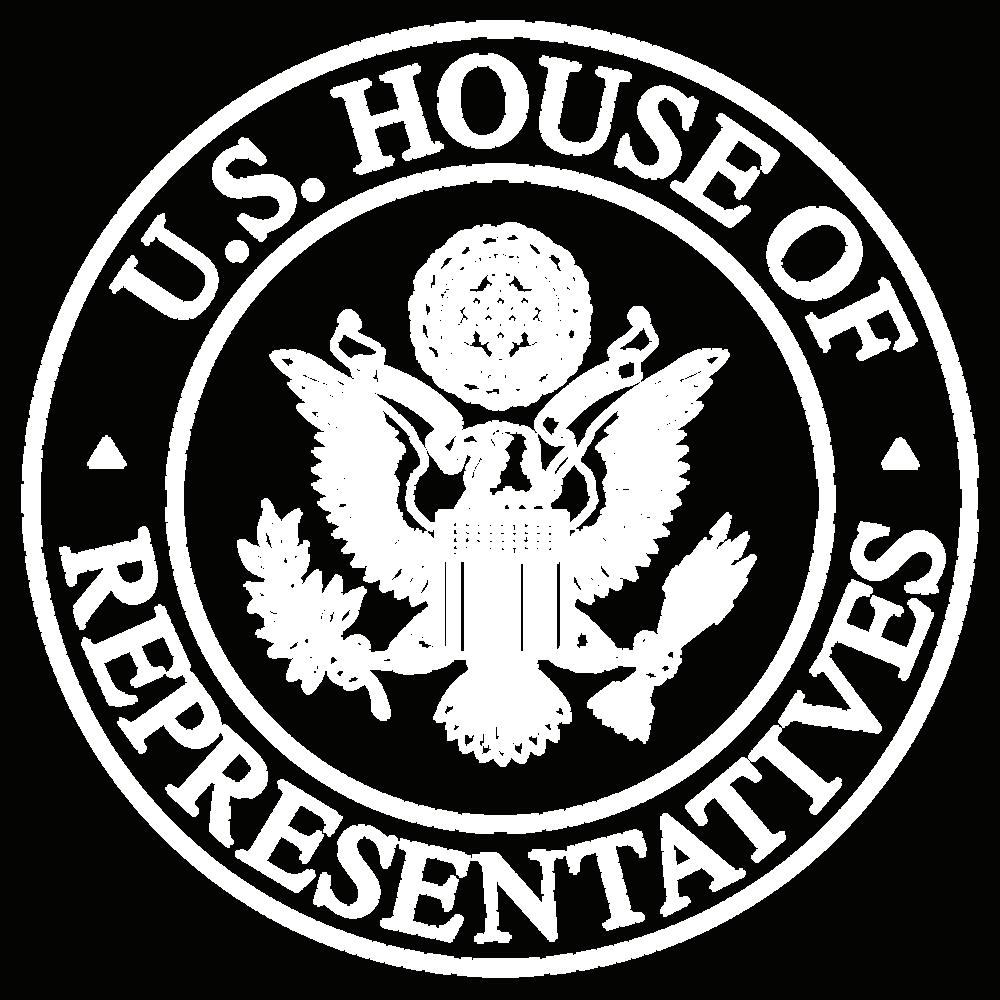
Thurmond called these companies to action to bolster state efforts.
“I think that the state is doing everything that it can, and our office is certainly taking the lead as it relates to our students, but we need everyone to help,” Thurmond said. “And that means internet companies have to find ways to help build out pieces of the infrastructure that will reach the homes of Californians.
S.A. In 2022, we lift up the four-year extension of our Sisters Mentally Mobilized Advocate Training Program among our biggest accomplishments.
The program has been successful in building a cadre of Black mental health advocates and activists in key regions of the state and we are so excited to continue the program through another four
S.A. [The new year] presents a great opportunity for expanded power building in the Black community in California to advocate for health equity, reparations, and continued recovery from the COVID-19 pandemic.

At California Black Women’s Health Project, collaboration is a guiding value and is absolutely necessary for our work to address health disparities, build communi-

CBM: What’s your wish for this holiday season?
Black culture, the loving spirit of Christmas, and the new year transition give me so much joy during the holiday season. This year my holiday wish is for a period of respite and peace, especially for those of us who work in community service. I also wish for a COVID-free Holiday season for us all.















Nation’s Largest Green Hydrogen Pipeline Moves California Closer


to ‘Net-Zero Goals’
By Aldon Thomas Stiles California Black Media
The California Public Utilities Commission (CPUC) on December 16 marked a milestone for the state’s 100% clean energy goals when it approved Southern California Gas Co.’s (SoCalGas) request to track costs for the first phase of the Angeles Link project.
Angeles Link is a green hydrogen pipeline system that offers an energy alternative to the Los Angeles region.
SoCalGas proposed the project last February.
Neil Navin, vice president of Clean Energy Innovations for SoCalGas, summarized how the project could help with the state’s goals.
“We were really excited to hear that the project is significant in
that it aligns with the state,” said Navin. “We believe that the project could be the nation’s largest green hydrogen pipeline system. Once it’s built, (It will deliver) significant benefits to decarbonize the hard-to-electrify sectors of the economy.”
Green hydrogen involves converting hydrogen gas into electricity or fuel to provide renewable energy as an alternative to finite fossil fuels.
“Green hydrogen looks promising as a form of long-duration energy storage that could enhance electric system reliability and as a fuel that can help California reach its net zero-carbon goals for industrial end uses that currently have no practical alternatives to the use of natural gas,” said Jan Smutny Jones of Independent Energy Pro-

ducers. “Establishing the memorandum account is a critical first step toward determining whether green hydrogen can supplement or replace natural gas and reduce carbon emissions from end users that are hard to electrify.”
The Angeles Link project aims to enable up to four natural gas power plants to run on hydrogen, remove over 3 million cars’ worth of nitrogen oxide and carbon dioxide from the air, bolster the economy and create union jobs, according to the SoCal Gas website.
“Green hydrogen is an important pathway to reach our goal of zero-emissions cargo operations at the Port,” said Port of Los Angeles Executive Director Gene Seroka. “The Port and our terminal partners have five active hydrogen
postnewsgroup.com THE POST, December 28, 2022 - January 3, 2023 Page 2
10,000-mile-long broadband network to provide open internet access statewide by the end of 2026.
Middle-Mile project was authorized by Senate Bill (SB) 156, announced by Newsom, Senate President pro Tempore Toni G. Atkins (D-San Diego), and Assembly Speaker Anthony Rendon (D-Lakewood) in July
TO AY: Barbara L O n b o u a j o y o u I t i s m y h o a n d I l o o t f o r p e a c n t a c t m y o f c y o r j u s t t o m o r e i m p o r t a n t t h a n m y c o n s t i t u e n t s C O N G R E S S W O M A N B A R B A R A L E E Oakland, California 1 Kaiser Plaza Suite 1010 Washington, DC 2470 Rayburn H Offi B ildi gton D 25-26 nquirie
The Middle-Mile Broadband Initiative will have a $6.5 billion budget to extend and improve internet access for “unserved and underserved communities.” Shutterstock photo.
Continued on page 9
By Ben Jealous
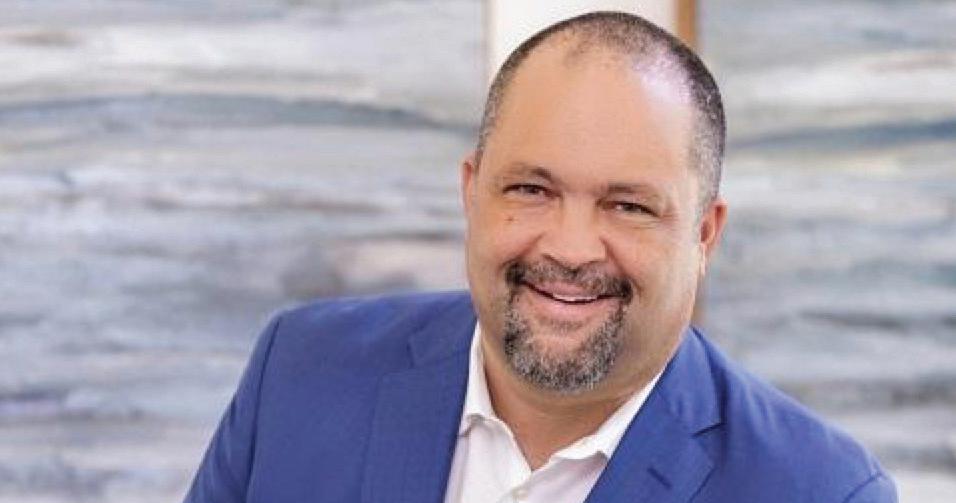
I’ve written about the importance of judges a few times over the last year. And every time I do, I realize that many people have never met a judge.

Or they have, but it was at a time when they’d rather have been anywhere else. So, the idea that judges are on my mind as something to celebrate this holiday season may strike you as strange. But bear with me.
Since President Biden came into office, he has made it a priority to nominate federal judges who are not only legal stars but are diverse, come from underrepresented professional backgrounds, and have a deep commitment to civil rights. Many of them have been civil rights lawyers or public defenders.
This is a real change, even from past Democratic presidents. For decades, presidents most often nominated corporate lawyers or prosecutors to the bench. Those people were also overwhelmingly white and male. Not anymore.
At the federal circuit level, which is the level above the district or trial courts and just be-






low the Supreme Court, 41% of Biden nominees have been Black. So far, more Black women have been confirmed to the circuit court bench than during all previous presidencies combined.
At the district level, Biden has nominated people of color, LGBTQ+ people, and people of diverse faiths, who are historic “firsts” on their respective courts. Not only that, but we have our first Black woman on the Supreme Court, Ketanji Brown Jackson. Her presence inspires me every day, even though there are many reasons to be dissatisfied with the Court’s far-right majority.

Thanks to President Biden, Senate Majority Leader Chuck Schumer and Senate Judiciary Committee Chair Dick Durbin, the pace of nominations and confirmations has been fast – very fast. This was critical, because during the Trump presidency, the Far Right raced to confirm as many ultraconservative judges as possible. President Biden is beating Trump’s pace with one of the fastest confirmation processes ever. As I write this, 97 lifetime federal judges have been con-
firmed in the first two years of Biden’s presidency. Trump had 85 in his first two years. Biden’s pace is the second-fastest in a quarter century.

And when the Senate returns in January, there will be a spectacular roster of nominees just waiting for the final step in their confirmation process: people like Nancy Abudu, an advocate for voting rights and civil rights through her work at the Southern Poverty Law Center and the ACLU; Natasha Merle, an advocate for racial justice at the NAACP Legal Defense and Educational Fund; Tiffany Cartwright, a civil rights litigator whose cases include police misconduct; and Julie Rikelman, the longtime litigation director for the Center for Reproductive Rights.
So why does all this matter?
It’s not just because having people from underrepresented communities on our courts is inspiring to see and long overdue. Both of those things are true. It’s because the nominations and confirmations represent the administration’s commitment to building fairer courts overall.
The Biden administration is actively seeking out judicial nomi-
By Tamara Shiloh
Contributions of African American women to the U.S. Military have been documented since the Revolutionary War (1775–1783). These women played major roles during the colonial period by providing help to the militia, supporting the slaveowner’s wife when he left for service, working alongside men in building forts for safety, and serving as spies.

During the War of 1812 (1812–1815), Black women cared for the farms so that white men could leave their homes and families to fight.
Black women took on nursing roles during the Spanish-American War (April–December 1898).
More than 75% of all deaths during this war resulted from typhoid and yellow fever. Black nurses were told that they were immune to the diseases because “their skin was darker and thicker.” Many therefore exposed themselves to the diseases, becoming casualties.
As the United States entered World War I (1914–1918), 14 Black women began to serve as uniformed U.S. Navy personnel. Some historians claim that the records of these women, dubbed the Golden 14, were lost. But researchers, including former naval officer and historian Jerri Bell, argue that the records are not lost, it just takes a “bit of specialized reading and interpretation of records” to piece together the entire unit.


The Golden 14, the first Black yeowomen, made important contributions to the war effort. They worked in a clerical capacity in the division that monitored and tracked soldiers throughout the war: The Mustering Personnel Division, led by John T. Risher, a Black seaman.
They were assigned to the U.S.S. Triton and based permanently stateside. The Muster Roll Division
THE POST, December 28, 2022 - January 3, 2023, Page 3 postnewsgroup.com This Holiday Season, Judges Give Us Something to Celebrate
Continued on page 9 Continued on page 9 Secure your family’s future— become a homeowner Owning a home is a great way to protect your family’s financial future. Union Bank® can help you find the mortgage that is right for you: • Discover down payment options as low as 3% • Receive down payment assistance grants from $9,000 to $12,000 with no payback of grant required1 • Take advantage of fast prequalifications2 • Enjoy competitive interest rates Call 877-498-3513 today to start building your legacy. ©2022 MUFG Union Bank, N.A. All rights reserved. Member FDIC. Union Bank is a registered trademark and brand name of MUFG Union Bank, N.A. unionbank.com Loans subject to credit and collateral approval. Not all loan programs are available in all states for all loan amounts. Terms and conditions subject to change. 1 Assistance provided is considered taxable income and will be subject to issuance of 1099-MISC to borrower. The borrower should consult their tax professional for any tax implications. 2 Not a commitment to lend. Prequalification is based on information provided by the consumer. Additional information must be submitted for review and approval. Union Bank NMLS ID #539249 The Golden 14: Forgotten Black Women Who Served in WWI
Ben Jealous
Photo from “Kelly Miller’s History of the World War for Human Rights.”
Bell. Sarkari Library.
Thom Bell, Co-Creator of the Sound of Philadelphia, Dead at 79
By Post Staff
Songwriter Thom Bell, a classically trained instrumentalist who wrote songs for 1970s singing groups Delfonics, Spinners and Stylistics, passed away at his home Bellingham, Wash., on Dec. 22. He was 79.
With Kenny Gamble and Leon Huff, Bell gained renown in creating what became known as the Sound of Philadelphia writing, arranging and producing songs for those soul groups as well as the O’Jays, Temptations, Little Anthony and the Imperials and individual artists including Phyllis Hyman, Lou Rawls, Teddy Pendergrass, Johnny Mathis, Dionne Warwick The Temptations, Phyllis Hyman, Dee Dee Bridgwater, Elton John, Fatboy Slim, Dusty Springfield, David Byrne, Joss Stone and more.
“Thom Bell left an indelible and everlasting mark on the history of popular music, but even more so, he will be remembered by all who knew him as a kind and loving friend and family man. The music world has truly lost one of the greats,” his attorney wrote in a statement published in Billboard magazine.
Born in 1943 and raised in West Philadelphia, Bell showed early talent as a musician and went on the road with Chubby Checker as a touring conductor in his early 20s. His familiarity with classical and global
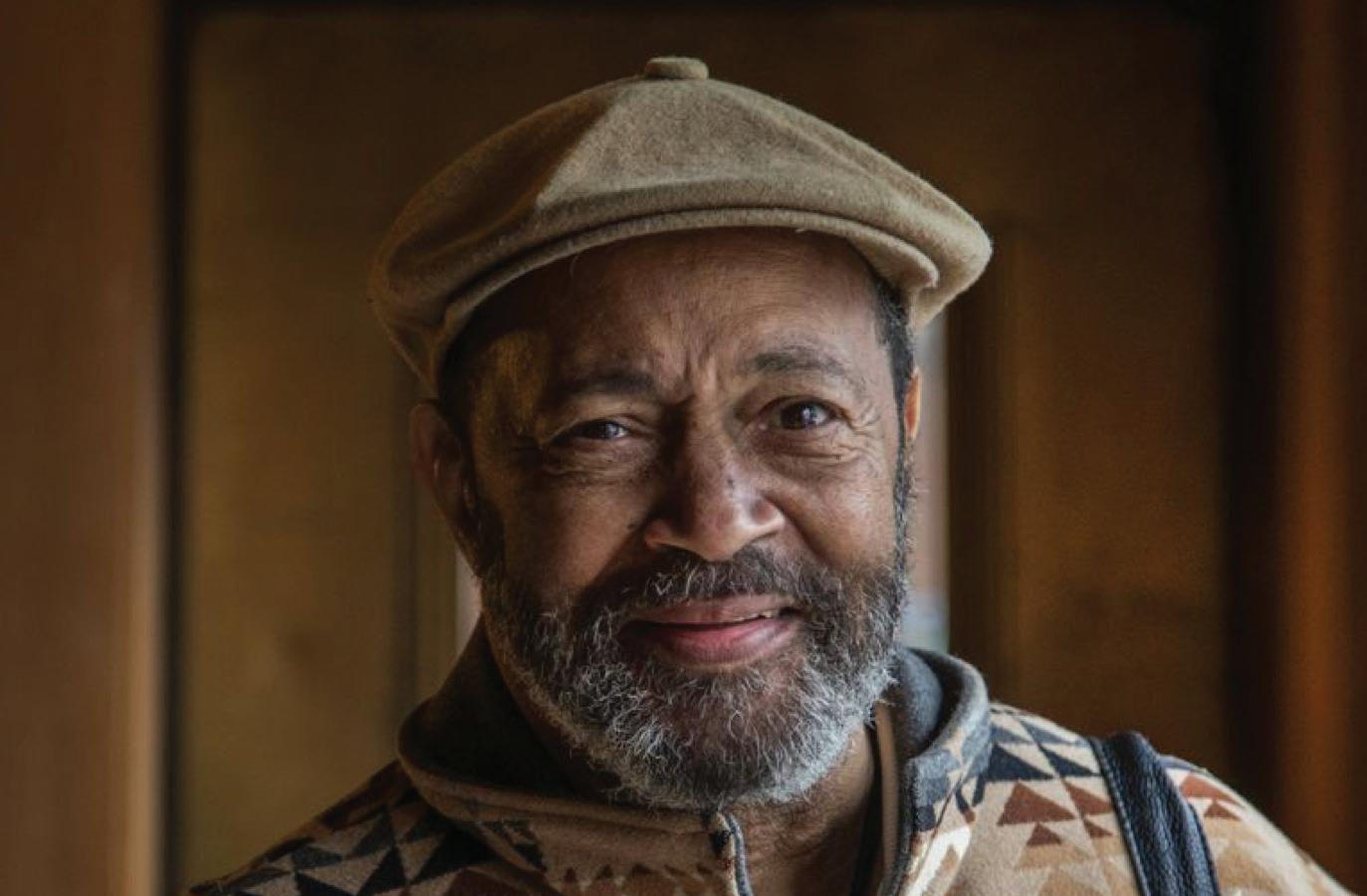
instruments like bassoons, oboe and sitars made his productions lush and full, influencing Soul music for some time afterwards.
His first production gig was in with the Delfonics, producing the hits “La-La Means I Love You,” and “Didn’t I Blow Your Mind This Time” in 1969. In 1972, he produced The Stylistics self-titled first album and later helped The Spinners achieve hits with “I’ll Be Around” and “Could It Be I’m Falling In Love.”
His 11-year partnership with fellow songwriter Linda Creed, yielded several more hits, among them “People Make the World Go Round,” and “You Are Everything.”
In 1975, Bell became the first winner in the Grammy category ‘Best Producer of the Year.’ He worked in the 1990s with James Ingram, David Byrne, Angela Winbush and Josh Stone. In 2006, he was inducted into the Songwriters Hall of Fame and won the Grammy Trustees Award in 2016.
Bell is survived by his wife, Vanessa, and children Royal, Troy, Tia, Mark, Cybell, and Christopher.
Vibe, Yahoo, The Songwriters Hall of Fame, The Seattle Times and Wikipedia were the sources for this report.
White House Responds to Migrant Buses Sent to VP Harris’ D.C. Home

“Trauma, Tresses & Truth: Untangling Our Hair Through Personal Narratives”
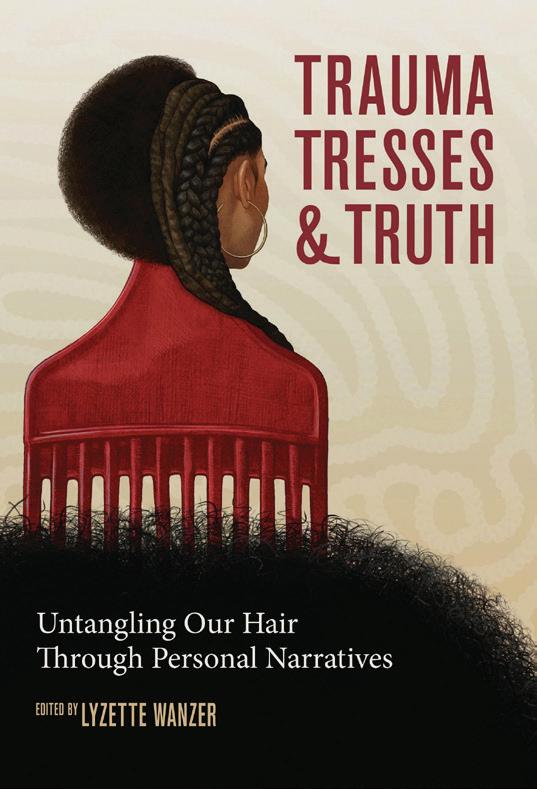 Edited by Lyzette Wanzer | c.2023, Lawrence Hill Books $19.99 255 pages
Edited by Lyzette Wanzer | c.2023, Lawrence Hill Books $19.99 255 pages
As for work, says one essayist, “A 2017 study confirms that Black women face bias in the workplace when wearing natural hairstyles.” It might happen with lowered tips at a restaurant job, a lack of promotion or a raise, or the loss of a job altogether — and for what?
Says another essayist, “My hair doesn’t do my job. I do.”
By Terri Schlichenmeyer
Your application was accepted.
The phone interview went well; the person you spoke with seemed impressed with your credentials, your education and experience. You laughed at the same jokes. Knew some of the same industry people. At the in-person interview, they told you that the job was yours — if you’d change one thing. “Trauma, Tresses & Truth,” edited by Lyzette Wanzer, combs through this irritation.
Nearly four years ago, thensenator Holly Mitchell of California wrote and sponsored what she called the CROWN Act, which prohibits discrimination based on hair style and texture. That summer, California passed the law and since then, other states and municipalities have followed suit. And yet, hassles happen on behalf of hair.
In times of slavery, hair was hidden to “restrict the appearance” of marketable women and to enforce conformity, and preference was given to slaves that had straighter hair and lighter skin. A century ago, advertisements for “hairdressing” promised to tame “kinky, snarly, ugly” hair. The availability of Madame C.J. Walker’s products showed that “Black women ... take [their] nappy hair and figure it out.”
Sometimes, though, it feels like “the Black body is a war zone and the Black skull, the helmet.” It happens to men, when people question their braids in professional settings, or they stereotype men with locs. It happens when a white person touches your hair or even asks to touch it. Worst of all, pelo malo (bad hair) are words that follow babies and small children who are too young to shout the word “no” or to choose for themselves.
A quick flip through “Trauma, Tresses & Truth” suggests that this book isn’t going to tell you anything that’s new. It is, in fact, quite a bit of preaching to the choir, since most people who will pick it up are living it. And yet, there’s appeal in these pages, and support, as though you’ve just entered a town hall meeting for Black women’s hair.
While it’s a fact that men are slightly represented in this book, the essayists that editor Lyzette Wanzer has pulled together are mostly Black and Puerto Rican women who write about earlier hairstyles in a manner that can make you sit back, sigh in remembered happiness, and let your shoulders relax. It’s not all good, though: some essayists recall tender-headed pain, Jheri curl messes, and embarrassment from long ago or last week. These memories, these exasperations, serve to weave camaraderie into each tale.
Clearly, this is a book for women, but Black men may likewise find words that’ll make sense to them, too. If you’re tired of hair harassment, read “Trauma, Tresses & Truth.” It’ll make your toes curl.
By Stacy M. Brown NNPA Newswire
The White House has condemned the latest tactic employed by Republican governors, including Texas’ Greg Abbott, and Arizona Gov. Doug Ducey, who have bused migrants across the country to push President Joe Biden toward stricter border policies.
The latest incident occurred on Christmas Eve amid sub-freezing temperatures.
Three buses carrying 139 migrants from Texas arrived outside Vice President Kamala Harris’ residence at the Naval Observatory.
Temperatures in the District of Columbia reached as low as single digits, with wind chill factors driving the real feel to minus zero.
Biden has called the moves “un-American” and “reckless.”
“This was a cruel, dangerous, and shameful stunt,” said White House spokesman Abdullah Hasan.
“As we have repeatedly said, we are willing to work with anyone – Republican or Democrat alike – on real solutions, like the comprehensive immigration reform and border security measures President Biden sent to Congress
on his first day in office, but these political games accomplish nothing and only put lives in danger,” Hasan asserted.
Amy Fischer, a core organizer with the Migrant Solidarity Mutual Aid Network, told ABC News that she was outside the Naval Observatory on Saturday night as buses began arriving after about 7:45 p.m.
Fischer said the migrants included “a bunch of families,” maybe around 30, as well as adults in groups like spouses and cousins and people traveling alone.
None of them wore cold weather gear, Fischer told the news outlet, though many had blankets to wrap up.
Fischer said that the “vast majority” were asylum-seekers, and all spoke Spanish, with people from Cuba, Ecuador, Peru, Colombia, and Nicaragua.
She added that Texas Gov. Abbott’s administration sent the migrants.
In August, the Texas Division of Emergency Management said that the state had spent more than $12 million busing migrants to Washington and New York crossed from Mexico.
A state government spread-
sheet that CNN obtained through a Freedom of Information Act request revealed that, as of August 9, Texas had paid $12,707,720.92 to Wynne Transportation, the charter service that is taking migrants to the two cities.
Additionally, the 43 buses that departed Arizona for the District of Columbia between May and August, carrying over 1,500 migrants, have cost that state more than $3 million.
Reportedly, the cost of each bus was approximately $83,000, bringing the total to date to around $3.5 million, according to the governor’s office, which said about two to three buses depart Arizona per week, based on demand.
In the two days since Fischer told ABC News, her group had helped people make further travel plans to their final destinations while a “handful of folks” who are planning to stay in D.C. have been relocated to a hotel as they prepare to put down roots.
She said the groups left on the buses from Texas, knowing they were headed to Washington.
“I think people are always a little bit confused. People are always a little bit scared,” Fischer said.
International Soccer Icon Pelé Dies at 82
By Stacy M. Brown NNPA Newswire
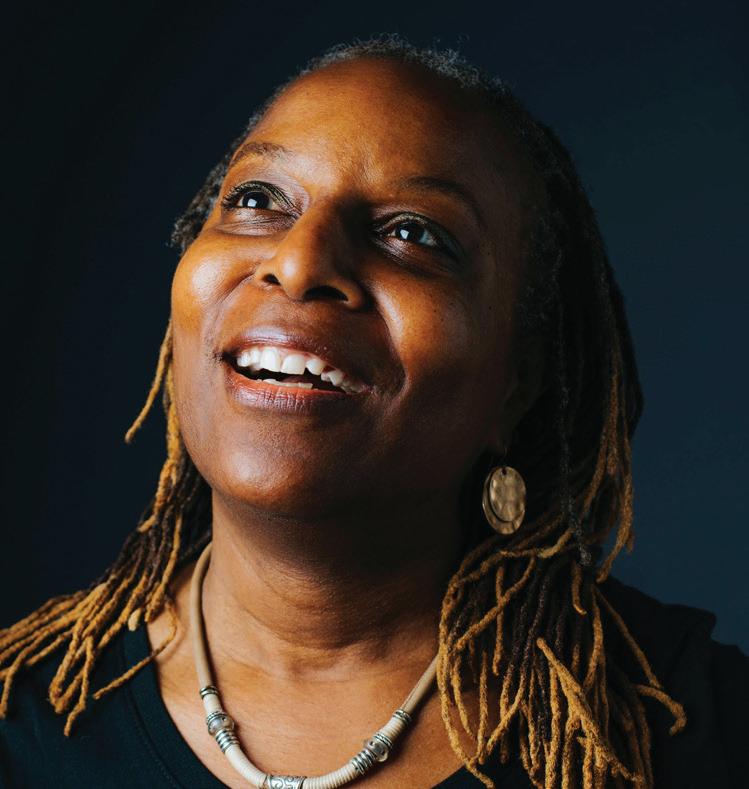
Pelé, the international star who was instrumental in three World Cup championships with Brazil across three decades and who energized U.S. soccer with the New York Cosmos in the 1970s, has died.
The 82-year-old legend had been hospitalized since November, and his doctors reported that Pelé’s cancer had advanced, requiring care related to renal and cardiac dysfunction.
He has been receiving regular treatment since doctors removed a tumor from his colon in 2021.
“Father. My strength is yours,” the international star’s son, Edinho, posted on social media.
Born Edson Arantes do Nascimento in Três Corações, Brazil, on Oct. 23, 1940, Pelé became soccer’s first superstar.
He led the Brazilian national teams to World Cup glory in 1958, 1962, and 1970.
In 1956, he joined the Santos Football Club, with Pelé, at inside left forward, winning nine São Paulo league championships and, in 1962 and 1963, the Libertadores Cup and the Intercontinental Club Cup.
Sometimes called “Pérola Negra” (“Black Pearl”), Pelé became a Brazilian national hero. According
to Britannica, he combined kicking power and accuracy with a remarkable ability to anticipate other players’ moves.
“After the 1958 World Cup, Pelé was declared a national treasure by the Brazilian government to ward off large offers from European clubs and ensure that he would remain in Brazil,” Britannica researchers wrote.
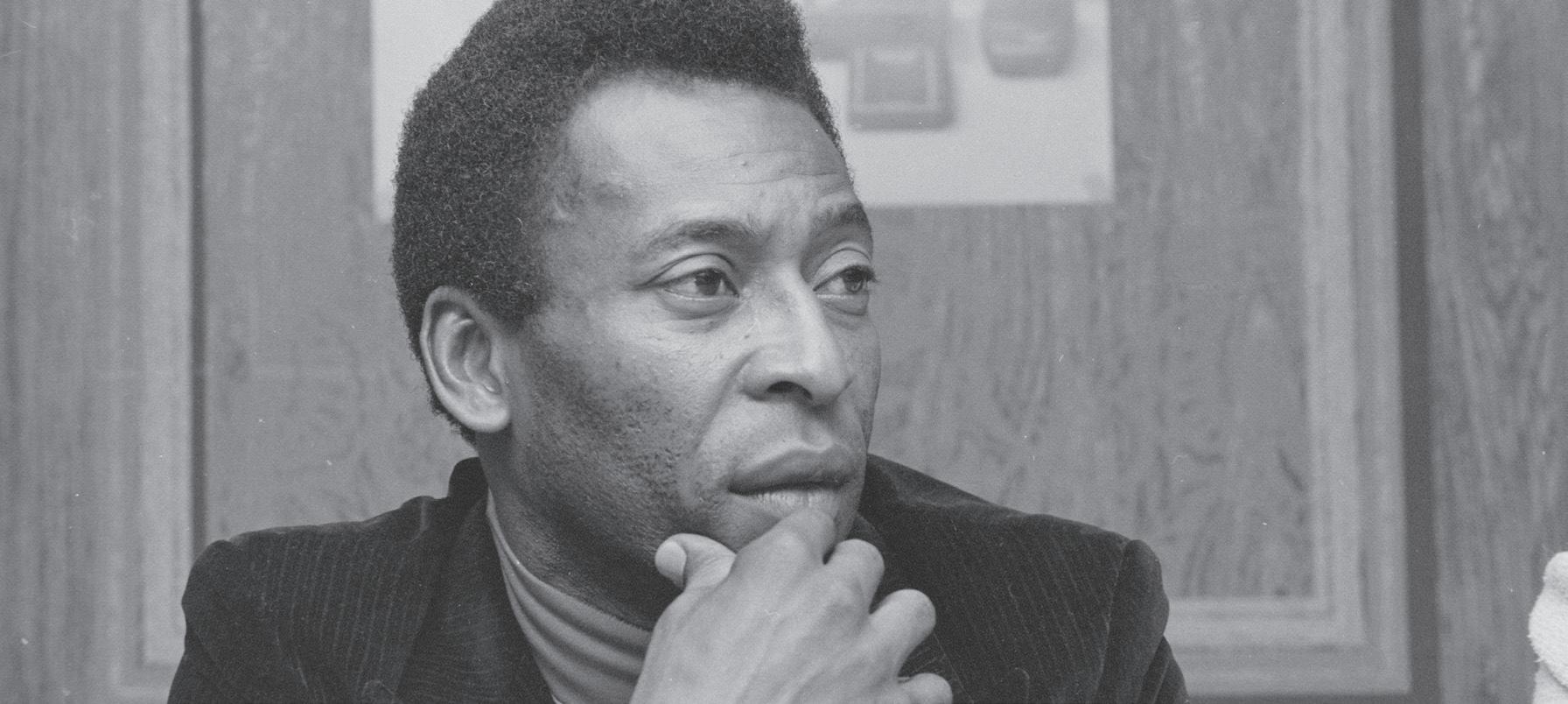
On Nov. 19, 1969, in his 909th first-class match, he scored his 1,000th goal.
Pelé made his international debut in 1957 at age 16 and played his first game in the World Cup finals in Sweden the following year.
The Brazilian manager was initially hesitant to play his young star. But, according to Britannica, when Pelé finally reached the field, he had an immediate impact, rattling the post with one shot and collecting an assist.
He had a hat trick in the semifinal against France and two goals in the championship game, where Brazil defeated Sweden 5–2. At the 1962 World Cup finals, Pelé tore a thigh muscle in the second match and had to sit out the remainder of the tournament.
Nonetheless, Brazil went on to claim its second World Cup title.
Researchers said rough play and injuries turned the 1966 World Cup into a disaster for Brazil and Pelé, as the team went out in the
first round, and he contemplated retiring from World Cup play.
Returning in 1970 for one more World Cup tournament, he teamed with young stars Jairzinho and Rivelino to claim Brazil’s third title and permanent ownership of the Jules Rimet Trophy. Pelé finished his World Cup career, scoring 12 goals in 14 games.
Pelé’s electrifying play and penchant for spectacular goals made him a worldwide star.
His team Santos toured internationally to take full advantage of his popularity. For example, in 1967, he and his team traveled to Nigeria, where a 48-hour ceasefire in that nation’s civil war was called to allow all to watch the great player.
Pelé announced his retirement in 1974 but, in 1975, agreed to a three-year $7 million contract with the New York Cosmos of the North American Soccer League and to promote the game in the United States. He retired after leading the Cosmos to the league championship in 1977.
Pelé was the recipient of the International Peace Award in 1978. In 1980 he was named Athlete of the Century by the French sports publication L’Equipe, and he received the same honor in 1999 from the International Olympic Committee. In 2014 the Pelé Museum opened in Santos, Brazil.
THE POST, December 28, 2022 - January 3, 2023, Page 5 postnewsgroup.com
Thom
Photo of Pelé in Mariott Hotel, Amsterdam, 1981. (Photo: Fotopersbureau De Boer / Wikimedia Commons)
Biden Administration Announces Plans to Drastically Reduce Homelessness Nationwide
BOOKS: The Best of 2022
BBy Terri Schlichenmeyer
It happens every year.
The decorations come down. The last of the Christmas leftovers have been eaten. Errant bits of ripped wrapping are found and discarded. You have no more holiday candy or cookies, you look around at your empty hands, and you wonder now what?
Now it’s time to settle in and read for the rest of the winter season. For your pleasure, here are the Top Five Bookworm Picks for the Best of 2022...

Fiction
By Stacy M. Brown NNPA Newswire
In major U.S. cities, officials have either ramped up or dialogued about efforts to reduce homelessness, with New York City Mayor Eric Adams announcing plans to place the unhoused with severe untreated mental illness into hospitals among the strategies employed.
Now, the Biden-Harris administration has decided to roll out a national push to reduce homelessness by 25% in two years.
Titled “All In: The Federal Strategic Plan to Prevent and End Homelessness,” the initiative, announced on Dec. 19, would mandate federal officials to intervene.
Various government agencies would work with states and cities to target unsheltered homelessness. In addition, the administration would expand housing and services and strengthen efforts to prevent people from being unhoused before they turn to the streets.
“Many Americans live each day without safe or stable housing,” Biden stated. “Some are in emergency shelters. Others live on our streets, exposed to the threats of violence, adverse weather, disease, and so many other dangers exacerbated by homelessness.”
The White House called the plan the “most ambitious effort by any administration to prevent people from becoming homeless, address inequities that disproportionately impact underserved communities, including people of color and other marginalized groups, and help cities and states reduce unsheltered homelessness.”
The “All In” plan outlines new strategies to prevent homelessness and increase the housing supply with supportive services to reach that goal.
Administration officials said these strategies build on the proven “Housing First” model – an approach where housing is the first step to a better, safer, and healthier life and serves as a platform for providing services so people can stay housed.
“All In” also sets the foundation for new initiatives, including one to reduce unsheltered homelessness in a cohort of geographically diverse communities.
Biden called on state and local governments to set goals for 2025 and use “All In” as a blueprint to address homelessness in their communities.

“My plan offers a roadmap for not only getting people into housing but also ensuring that they have access to the support, services, and
income that allow them to thrive,” Biden asserted.
“It is a plan that is grounded in the best evidence and aims to improve equity and strengthen collaboration at all levels.”
White House officials said “All In” builds on the Obama-Biden Administration’s efforts to prevent and reduce homelessness, including using proven strategies that led to a significant drop in homelessness between 2010 and 2016.
Officials contended that some of those gains were reversed between 2016 and the pandemic’s beginning due to a lack of focus on evidence-based strategies, officials contended.
The number of people experiencing homelessness increased by 6%, officials stated.
New data from the Department of Housing and Urban Development (HUD) shows that further increases in homelessness were largely avoided despite the economic crisis created by the COVID–19 pandemic – in large part because of the Biden administration’s robust response, including critical assistance in the American Rescue Plan and a historic economic recovery.
According to HUD data, 582,462 people were experiencing homelessness on a single night in January 2022 – a slight .3% increase since 2020.
The unsheltered homeless population, including encampments, has increased by more than 3% since 2020. In addition, chronic homelessness, including those with disabilities, increased by 15%.
In New York,65,633 lived in shelters in October 2022, compared with 57,341 in October 2020, according to the Coalition for the Homeless.
The Los Angeles region, which recently counted 69,144 people experiencing homelessness, has realized recent increases, including a 25% jump from 2018 to 2020.
Homelessness has reportedly decreased by 47% in the District of Columbia since 2016.
Because the Biden-Harris administration kept the national eviction moratorium in place until August 2021 and with support from the American Rescue Plan, evictions were prevented, and many vulnerable families could stay in their homes, officials insisted.
The Emergency Rental Assis-
Lovers of fairy tales are in for a big surprise with “The Book Eaters” by Sunyi Dean (Tor, $26.99). It’s a dark, dark legend filled with evil dragons that look like men, princesses that are worse than second-class citizens within their realms, and a chase that will chill you. Book lovers will adore this tale, especially if you don’t necessarily need a happily-ever-after.

Pick up a copy of “Dot and Ralphie” by Amy Hoffman (University of Wisconsin Press, $16.95) and it doesn’t look like much, but aren’t you glad you don’t judge a book by its cover? This is a sweet tale of two elderly women, partners in life and love, and aging. It’s sweet and grumpy and charming, somewhat like a lesbian Honeymooners episode, only better.

Readers who are familiar with the thrillers that James Lee Burke writes will absolutely be stunned by “Every Cloak Rolled in Blood” (Simon & Schuster, $27.00) because in this book, the thrill is secondary to the main plot. Here, retired detective Aaron Broussard has lost his beloved daughter and it’s cut him to the core. Fiery, glass-sharp grief doesn’t stop crime, though, and so he still has crime to solve — whether real, or imagined. Read this book with an open heart and tissues at hand. It may be Burke’s best.

Lovers of clever, clever stories will love “Sign Here” by Claudia Lux (Berkeley, $27.00). It’s the tale of Peyote Trip, whose job on the Fifth Floor of Hell is to recruit new souls for eternity. But Pey has a plan to get out of his purgatory, which turns this funny, sharp-witted story into a shady mystery that will make you laugh a lot and squirm even more.

Here’s a book that’s absolutely not for everyone: “Manhunt” by Gretchen Felker-Martin (Macmillan Nightfire, $17.99) is a lesbian feminist dystopian thriller, which sounds like a lot and it is. A virus has hit every corner of the world, making men into wolf-like killing machines and sending the women into hiding. When two young women — one of them, trans — learns that a “healer” might be able to save her from the inevitable, they head out to find the woman but a makeshift band of warrior women get in their way. Again, this isn’t a book for everyone but if you’re looking for something very, very different, this is it.

BONUS BOOK: “Things Past Telling” by Sheila Williams (Amistad, $25.99) is a novel of the memories of a 112-yearold former slave, who was also a pirate’s woman, a healer, and someone reaching for things her soul needed. It’s an adventurous book with the tiniest touch of fantasy and you shouldn’t miss it.

Non-Fiction
You have questions. And “All the Living and the Dead” by Hayley Campbell (St. Martin’s Press, $29.99) has answers. When someone dies, what happens next? A wide variety of things, that’s what, and it’s someone else’s job to see that it’s done right. This book is careful not to be (too) gruesome but it is compellingly fascinating.
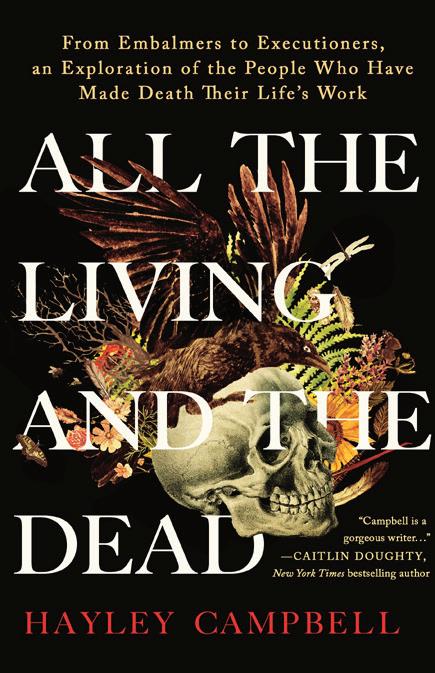
“Charlie’s Good Tonight” by Paul Sexton (Harper, $27.99) is on this list because it could be the biggest surprise of the year for readers. It’s the story of the late Rolling Stones drummer Charlie Watts, a man who really never wanted fame and often actively shunned the limelight. If you think you know all about the debauchery of your favorite rock & roll band, think again and be totally charmed by one man’s life.

There are two business books on this list because they don’t at all read like business books; in fact, “Think Like a Horse” by Grant Golliher (Putnam, $28.00) and “Meet Me by the Fountain” by Alexandra Lange (Bloomsbury, $28.00) both seem more like snuggle-up-in-front-ofthe-fire kinds of books. Golliher’s book is pure cowboy — he was a rancher and worked extensively with horses — and there are western-novel tones in his book on getting the most out of people. Lange’s book is a trip to the mall throughout history, including a good look at stores you may have visited through the years. These books are both great for the businessminded reader, but could be enjoyed by anyone.


And finally, an obsession: “To Walk About in Freedom” by Carole Emberton (W.W. Norton, $28.95) is a jaw-dropping memoir that hides in a history book. In the earlier part of the last century, the government paid writers to interview people for a WPA project. One of the interviewees was a former slave woman who offers up not only her life, but a real-life account of the end of slavery and how it impacted everyday, average people. This is a book you’ll be talking about well into the new year.
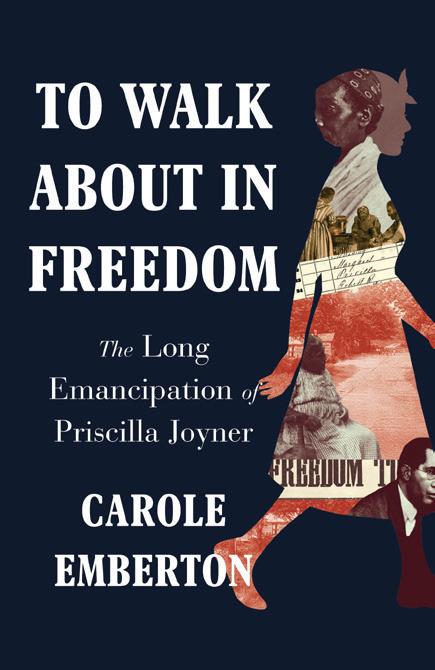
If these eleven books don’t fit your mood, then be sure to check with your favorite bookseller or librarian. When it comes to books, (s)he is a superhero.
Happy Reading!

postnewsgroup.com THE POST, December 28, 2022 - January 3, 2023, Page 8
The “All In” plan outlines new strategies to prevent homelessness and increase the housing supply with supportive services to reach that goal.
Continued on page 9
Nation’s Largest Green Hydrogen Pipeline Chett
demonstration projects and, ultimately, Angeles Link can play a key role in providing green hydrogen at the scale needed to achieve our zero-emissions and decarbonization goals by 2030.”
The plan for the project is structured into three phases.
Phase I would look at early engineering scoping and would establish a public engagement process. It will take about 12 to 18 months, according to Navin.
Phase II will “expand on the engineering and look at narrowing down the possible locations for the infrastructure,” Navin said.
Phase III will involve more detailed engineering planning before applying for a Certificate for Public Convenience and Necessity. This certificate will allow for the construction of the infrastructure.
Describing the state’s assistance on this project, Navin said, “Certainly, the governor’s budget has dollars specifically directed towards hydrogen technology. We also see in the California Energy Commission and the California Air Resources Board a real emphasis on the potential for green and clean hydrogen to have a significant impact. So, we see the state moving toward – and really emphasizing – the need to develop hydrogen infrastructure for the hard-to-electri-
fy sectors of our economy.”
Navin claimed that Angeles Link will have a positive effect on the state’s economy.
“And we really believe that Angeles Link could be an economic boom that extends California’s position as a leader in clean energy well into the future, that takes advantage of the thousands of skilled workers that we have in our company, and the more than 32,000 workers that already exist in the gas distribution industry, and it allows them to participate meaningfully in the transition,” Navin said.
SoCalGas Chief Executive Officer Scott Drury echoed the sentiment that California is a leader in renewable energy.
“California has some of the boldest climate and clean air goals in the nation.” Drury. “The proposed Angeles Link aligns SoCalGas’ scale, 150 years of expertise in service, and our highly skilled workforce with the clean energy and environmental policies that will shape this century. As the CPUC’s decision highlights, Angeles Link has the potential to support decarbonization for hard-toelectrify sectors of our economy, improve our air quality, bring new economic opportunities as well as sustain and grow skilled jobs to our region.”
Judges Give Us Something to Celebrate
nees who will improve the quality of decision-making on our courts because of the lived experience they bring. It’s seeking people who have seen the justice system from all sides, in their work or in life. People who are committed to upholding rights for everyone, not just the wealthy or privileged. And already, decisions by fair- minded Biden nominees have improved justice for many Americans in areas like workers’ rights and the environment.
When we have fair judges and fair courts, our lives are dramatically better. Fair courts hold police officers accountable for brutality. Fair courts protect our right to vote and strike down laws aimed at voter suppression. Fair courts protect our jobs, our air and water, and our right to health care, including abortion care. The list goes on and on.
So, in addition to celebrating
all the great new judges the Biden administration and Senate leadership have given us, there’s one more thing we can do. All of us can call our senators’ offices in January and encourage them to keep up to the momentum by confirming all the rest of the president’s judicial nominees. It’s an easy way to make a difference.
As I’m thinking of things to be thankful for this holiday season, I’m thankful that many of our federal courts really are changing for the better. So many of the rights and freedoms we’ve worked for in the past and will work for in the future depend on this progress. We need to keep it going.
Ben Jealous serves as president of People For the American Way and Professor of the Practice at the University of Pennsylvania. A New York Times best-selling author, his next book will be published by Harper Collins in January 2023.
Forgotten Black Women Who Served in WWI
Continued from page 3 worked from Wash., D.C., which was segregated through WWI, as was the Navy. The 14 were not allowed at sea, their gender and race denying them that opportunity. They never appeared on revolving muster rolls or ship logs to track their movements.
A muster roll is an official list of officers and men in a military unit or ship’s company. Not being a part of it is partly how history overlooked the 14 and claimed that World War II was the beginning of Black naval service as yeomen.
The 14 women all shared an “initial rejection of service due to a medical disqualification,” according to former naval officer and historian Jerri Bell. Their Official Military Personnel files contain notes or memos recommending them for service specifically to the Muster Roll Division.
“This fact may support the theory that Risher individually and purposefully built this division to his specifications. By having women that would otherwise be
unfit for service, Risher may have had an easier time convincing the Navy to let him pool their service together in his command despite their gender and skin color.”
Notwithstanding racism and sexism, the Golden 14 entered the naval ranks. Their success opened doors for those who, during WWII, would become the first Black navy officers: The Golden 13.
Learn more about Blacks who served admirably in various wars in Robert Edgerton’s “Hidden Heroism: Black Soldiers in America’s Wars.”
Source: http://lestweforget.hamptonu.edu/page. cfm?uuid=9FEC3F39-A1CB50EA-40E8D72CC8BED35F
https://rediscoveringblack-history.blogs.archives. gov/2020/11/09/golden-14/
https://www.history.navy.mil/ browse-by-topic/diversity/african-americans/chronology.html
Image: https://boundarystones. weta.org/2018/08/07/womenwar-navys-first-african-americanyeomanettes
among youth ages 15-24.
There are incredible challenges to restoring our collective well-being. I’m grateful for programs like our Community Responsive Wellness Program that connects Black youth and families with community and mental health services in Sacramento. Connection is a key component of mental health.
CBM: What are you most looking forward to in 2023?
C.H.: The Center launched the Community Economic Mobilization Initiative this year that will invest $19 million into equipping our communities to drive economic development.
Equitable access to opportunity leads to greater health and wellbeing.
I’m looking forward to seeing more public funds in the hands of our communities.
CBM: What’s the biggest challenge Black Californians will face next year?
C.H.: It’s a watershed moment for Black Californians and their communities across our state.
The federal and state governments are investing billions into pandemic recovery and growing the Green economy.
For our community’s long-term health and prosperity, we need to work hard to ensure our children, youth and young adults have equitable access to the education, training and employment opportunities these historic investments in infrastructure and climate resilient industry will generate.
CBM: What’s your wish for this holiday season?
During this season and beyond, I wish everyone joy, loving relationships and a sustaining community. We all deserve to be well.
Registering for the WCCUSD Is as Easy as 1-2-3
By Kathy Chouteau
The West Contra County Unified School District (WCCUSD) has released its 2022-2023 New Family Enrollment process, and it’s as simple as three steps.

First, visit bit.ly/wccusdschoolsitelocator to identify your resident school in WCCUSD. There will be an interactive School Site Locator where you can enter your address in the search box or just browse through the map.
Next, register online at wccusd. net/newfamilyenrollment. In order to register, you’ll need an email account, a Power Schools account (set up during online registration) and the required documents ready to upload. To register for school, you will need: Verification of residency (two); age verification: birth certificate, Baptismal record or passport; immunization record; parent, guardian or caregiver ID (one); and documents required under special circumstances, per the WCCUSD.
Finally, you should schedule an appointment at your resident school since registration isn’t complete until you meet with your school inperson. Be prepared to show your ID for verification and the same documentation used during registration.
Learn more at https://www.wccusd.net/newfamilyenrollment
By Stacy M. Brown NNPA Newswire

The U.S. Postal Service (USPS) has announced an historic, $9.6 billion investment over the next five years to electrify its delivery fleet.
The USPS investment includes electrifying 75% of its new purpose-built Next Generation Delivery Vehicles (NGDV) and a commitment to acquire 100% electric NGDVs starting in 2026.
The $9.6 billion investment –which includes $3 billion in funding from the Inflation Reduction Act – installs modern charging infrastructure at hundreds of USPS facilities, electrifies 66,000 delivery vehicles, “and modernizes mail delivery by creating a smarter network to more efficiently reach its 163 million delivery locations across the country and further strengthen the sustainability of this critical public service,” White House officials said.
Earlier this year, President Joe Biden signed the Inflation Reduction Act to help bring down everyday costs – including costs for energy.
Administration officials said the Inflation Reduction Act’s once-in-a-generation investment in America’s infrastructure “delivers the most significant action ever to tackle the climate crisis and strengthen U.S. energy security, including $3 billion to modernize the USPS delivery fleet.”.
Biden’s ambitious goal for 50% of new vehicles sold in 2030 to be electric has accelerated investments and jumpstarted the EV market in America, officials said.
Since Biden took office, U.S. electric vehicle sales reportedly have tripled.
One year ago, through the president’s Executive Order on Catalyzing Clean Energy Industries and Jobs Through Federal Sustainability, the Biden-Harris Administration released the most ambitious sustainability plan ever, establishing a goal for 100% acquisition of zero emission light-duty vehicles by 2027 and medium- and heavy-
Administration
duty vehicles by 2035.
Now, the USPS said it would exceed Biden’s requirement for each agency to electrify its federal fleet.

Over the next five years, the Postal Service will purchase 45,000 specialized USPS NGDV electric vehicles and 21,000 commercial off-the-shelf electric vehicles.
“We commend the U.S. Postal Service,” John Podesta, Senior Advisor to the President, said in a news release.
“The USPS plan leverages the $3 billion provided by the Inflation Reduction Act to hit the target of 100% electric delivery vehicle purchases in 2026, sets the postal fleet on a course for electrification, significantly reduces vehicles miles traveled in the network, and places USPS at the forefront of the clean transportation revolution.”
The U.S. government operates the largest vehicle fleet in the world, and USPS is the largest vehicle fleet in the Federal government.
In the plan, the USPS invests the full $3 billion in Inflation Reduction Act funds to increase ambition and pace in electrifying its fleet, including $1.3 billion for electric delivery vehicles and $1.7 billion for charging infrastructure.
Coupled with $6.6 billion in USPS funds, the overall $9.6 billion, 100,000-vehicle modernization plan results in 66,000 electric delivery vehicles and tens of thousands of charging stations through 2028, and a target of acquiring only electric delivery vehicles after 2026.
“The U.S. Postal Service plan sets the pace for other leading public and private sector fleets. It is clear that the future of transportation is electric – and that future is here,” said Council on Environmental Quality Chair Brenda Mallory.
“As electric mail trucks hit routes across the country, neighborhoods will see cleaner air, better health, and good-paying clean energy jobs.”
tance program from the American Rescue Plan delivered over 8 million payments to provide rental or utility assistance to individuals at risk for eviction or housing instability.

And the expanded Child Tax Credit helped drive child poverty to record lows in 2021. As a result, eviction filings remained more than 20% below historic averages in the 12 months following the expiration of the national eviction moratorium.
Despite overall homelessness remaining relatively flat, the administration noted that the number of people experiencing unsheltered homelessness—including people living in cars and tents – rose by 3%.
“Ending unsheltered homelessness will require a coordinated effort to promote healthy and safe communities where all can live in dignity,” administration officials wrote in a fact sheet.
“Effective practices, such as using an emergency management approach to resolve encampments by rapidly moving people into housing with services and supports, are starting to emerge as national models.
“Although each community is different, and there is no one-sizefits-all solution, these practices could be successfully replicated in communities facing the growing challenge of unsheltered homelessness.”
1111 Broadway, Suite 800, Oakland, CA 94607 (510) 208-7400 • www.alamedactc.org
Request for Proposals (RFP)

Investment Advisory
Services
(RFP No. R23-0006)
The Alameda County Transportation Commission (Alameda CTC) is seeking proposals for a contract to commence services on July 1, 2023, or as indicated in the RFP and/or appropriate addenda.

Key Date: Proposal due date: January 27, 2023 at 3:00 p.m. PT
Proposals are subject to Alameda CTC’s Local Business Contract Equity Program. The Program goals for professional services are 70% for Local Business Enterprise (LBE) and 30% for Small LBE. For Program requirements and forms, visit Alameda CTC’s website. Any contract resulting from this RFP will be awarded without discrimination based on race, color, religion, sex, sexual orientation or national origin.
All RFP documents are available at www.alamedactc.org/contracting-opportunities. All questions regarding this RFP must be submitted in writing to vvijil@alamedactc.org, no later than 3:00 p.m. PT on January 6, 2023.
Submittals must be made in accordance with the instructions in the RFP. Any contract awarded must be in compliance with the local, state, and/or federal requirements.
postnewsgroup.com THE POST, December 28, 2022 - January 3, 2023, Page 9
Hewitt... Continued from page 2 Continued from page 6
Biden Administration Announces Plans to Drastically Reduce Homelessness
Nationwide Continued from page 3 Continued from page 8
24-7 Mortgage Loans 1556 Fitzgerald Drive #271 Pinole, CA 94564 510-757-3659 Mobile 510-200-9714 Office - 877-247-7009 Efax www.24-7mtgloans.com • 0 DOWN VA/USDA/FHA • 580 FICO PROGRAMS • JUMBO LOANS TO $5 MILLION • PRIOR BK or SHORT SALE • Borrowers with LOW or NO FICO s - s • Borrower w/Work Permits Non Resident Alien OK • Financing in NEW DEVELOPMENT s • FIRST TIME BUYERS SPECIALIST • PRIVATE and HARD MONEY 10 Day Closings NEW PROGRAMSOur Specialty is: "No Income Qualification Programs" for - - Non Owner SFR's, 2 4 Units, 5+ Unit Apartment Buildings, Mixed Use and Commercial L C Fuller Jr. Owner/ Broker CA DRE #01201700 NMLS#358884 “YOUR LENDER OF CHOICE” • Bank Statement Loans/P&L Statement Loans
Photo via Pexels courtesy of The Richmond Standard.
Biden-Harris
Announces Historic Investment to Electrify U.S. Postal Service Fleet
COMMENTARY: Will The First Asian American President of Purdue University Northwest Fire Its Racist Chancellor in 2023?

nation about Asian Americans and social justice, had it been handled properly.
We are, after all, coming out of a three-year period where the organization #StopAAPIHate has recorded more than 11,000 hate instances against AAPIs. From minor to major transgressions, from verbal slights to aggressive assaults — sometimes resulting in death.
This is the hate that’s emerged in American society since Donald Trump began scapegoating Asian Americans for what he called the “Kung Flu” and “China Virus.”
shouldn’t lose his job or be forced into retirement.
It’s a kind of gaslighting 2.0.
It happened; we’re not going to pretend it didn’t happen.
But we’re going to treat the perpetrator like it didn’t happen.
Everyone thinks about poor Chancellor Keon.
No one thinks about people like Vichar Ratanapakdee, the 84-yearold Thai man who was killed in San Francisco on Jan. 28, 2021, after he was shoved to the ground in a hate attack.
By Emil Guillermo
Oakland, with its new Asian American mayor, is one of the most diverse cities in America.
How many times do you think Mayor Sheng Thao, an Asian American of Hmong descent, has heard someone make fun of her and all Asian Americans with some accented joke?
That’s why the racist comment by Thomas Keon, the chancellor and CEO of Purdue University Northwest really matters.
And the one person who can give us a sense of justice, ironically, is Dr. Mung Chiang, an Asian American immigrant from Hong Kong, set to become the next president of Purdue University on Jan. 1.
This is an important moment in Asian American history.
This all started on Dec. 10 at the commencement of Purdue Northwest, just south of Chicago in Hammond, Ind. Keon, a white educated man in accounting, acted the dumb white insensitive male and used an accent that sounded like doggerel but in fact was Asian. We know because he admitted it while in the act. The astonishing self-awareness of a racist.
See the video for full context if you missed it: (A keynote speaker ends, then Keon walks up and delivers an anti-Asian slur) https:// www.youtube.com/clip/UgkxmOYq9oO5PqPLA470oR2D1d2Umwib5VC-.
This situation could have been a teaching moment for the entire
And Keon’s slur shows us that both he and the nation still don’t get it. Keon should have stepped down immediately from his leadership role of an institution of higher learning.
It’s an example all America needs to see.
No Resignation
Instead, Keon, the accounting guy, wasn’t held fully accountable for the harm his public speech caused. Four days after the slur, Keon finally issued a kind of bureaucratic apology on Dec. 14, indicating the slur didn’t express his values or the university’s. The Board of Trustees, not wanting controversy, hastily accepted.
That’s when the faculty senate became enraged and voted to demand Keon’s resignation. And when that didn’t happen, a majority of Purdue Northwest’s tenuretrack and clinical faculty, including department heads and deans, gave Keon a “no confidence” vote, 135 to 20.
It was his second no confidence vote this year. And Keon still didn’t resign.
And yet the attempts by the board to save Keon’s job have been extraordinary.
Most amusing is how everyone knows it’s racist, and yet, there is such a willingness to discount it as if there is no real infraction.
African American scholar John McWhorter in the New York Times defended Keon, acknowledging racism but saying that Keon
And he’s just one victim among thousands. The hate starts with an accent that “others” us and makes AAPIs vulnerable.
But the Purdue Board of Trustees, though recognizing the racism, wants to see a pattern in Keon’s behavior before they go beyond a reprimand. The faculty disagrees.
“There should be consequences for his behavior, and a reprimand is not the answer,” a tenured AAPI faculty member of PNW said in an email to me on Tuesday. “His behavior is a trigger for many and is still disturbing. He should resign or be fired. I am still livid.”
If the board doesn’t act, then justice is up to the next president of Purdue, Dr. Mung Chiang.
He’s a young hot shot academic, a Hong Kong immigrant who went to Stanford, starred in engineering at Princeton, and was lured to head the engineering school at Purdue for the last five years. More revealing is his stint as science advisor to the xenophobic and racist Trump administration.
That would signal a real change in America. The first Asian American president fires the racist chancellor who told a bad joke with an Asian American slur.
That’s almost too good to be true.
Just think. Would Keon still be on the job if he said the “N” word?
Emil Guillermo is a journalist and commentator. His talk show is on www.amok.com
Post Publisher in Selma March with Dr. King
Continued from page 1
William Battles, Black, and Paul Cobb, Black. Except for Hare, who died this year, all of us are still living.
We had all known each other since high school and college.
Growing up as Pathfinders we were committed to “serving our communities as volunteers and Christian outreach workers.” And after I introduced them to John Lewis, the former head of S.N.C.C. (the Student Non-Violent Coordinating Committee), we soon learned that we had enrolled, willy-nilly, in a crash course of how to get in his
brand of “good trouble,” but also more importantly, how to pray to get out of good trouble before things got too bad. When we were driving through Mississippi constantly looking out for the highway police, we eventually came to that infamous sign that read “ Gov. George Wallace welcomes you to Alabama.” We sang that spiritual “Way down yonder by myself and I couldn’t hear nobody pray.”
Our high school and college mottos were “Enter to learn and go forth to serve.”
Through this series of articles, I will point out the significant role
the bay area played as part of the intellectual, faith-based, political, and activist contributions to the various Black movements throughout this country and the umbilical connections to Dr. King and the SCLC.
I invite many of our readers who either marched with, worked with, or were inspired by Dr.King to send us your words, because Black History is not to be celebrated only at Kwanzaa or on Jan. 15th, or during February’s Black History Month observances. Every day is Black History Day at the Post News Group.
Statue of Henrietta Lacks
made tremendous contributions to modern medical research without her knowledge or consent.
In a video of a Dec. 19 press conference posted on the city’s Facebook page, it was announced that a statue honoring Henrietta Lacks will be unveiled in fall of 2023 in the very place that once held a monument dedicated to Confederate General Robert E. Lee.

The new statue’s permanent home, which was once named Lee Plaza, was renamed Lacks Plaza
Monument
in Henrietta’s honor.
Civil Rights attorney Ben Crump, who was on hand for the press conference, said the new Lacks statue is a step toward healing some of the racial divisions of the past. “In the past, we commemorated a lot of men with statues that divided us,” he said.
“Here in Roanoke, Va., we will have a statue of a Black woman who brings us all together.”
Fundraisers collected over
Formerly Incarcerated Group Seeks Partners to Address Homeless Crisis
By Richard Johnson
There is a real state of emergency that is taking place right before our very eyes. This emergency of homelessness has impacted every sector of our society and it’s not getting better.
This crisis has a foothold in nearly all major cities as well as rural and smaller areas in California. All across the state steps are being made to bring resolution to this crisis. In some cities, the need is more urgent than in others.
Gov. Gavin Newsom has put aside funds to combat this pandemic of homelessness. But real solutions are still lacking. People are literally dying as a result of inaction by the power brokers, community leaders, and some religious quarters of society.
This is unacceptable. We can and must do better. I am working with some other groups to complete a clear plan to present to the new Mayor and all city councilmembers, supervisors, clergymen, developers, and nonprofits who really desire productive change
by tackling homelessness, joblessness, crime, and violence as the highest priority of the new administration.
The Formerly Incarcerated Giving Back organization has been meeting with Jonathan Jones, a member of African American Sports & Entertainment Group (AASEG), Dr. Maritony-Yamot, and the Life Impact for Humanity (L.I.F.H) program to complete our plan for affordable housing in Oakland.
We want to meet with the Mayor-elect Sheng Thao as a follow-up to our first meeting held at the PIC offices while she was running for office.
At that meeting, Thao stated, “I would like to focus on addressing this issue of homelessness in my first 100 days as the new Mayor of Oakland.”

L.I.F.H. believes the solutions must involve faith-based and community leaders.
L.I.F.H. is an outreach program that partners with leaders in the community to bring about change
and stability. We want to establish programs to equip homeless veterans, elders, disabled, single parents, and family incarcerated through programs to be pillars of the community and society.
We can equip the youth with tools to build for their future and to help sustain their community. We want to provide each individual with opportunities to succeed in all spheres of influence such as family, religion, government, education, business, science, innovation, technology, media, arts, and entertainment.
The robust plan will allow for unity and diversity, and it will take a leap of faith to work together to save our community, while demonstrating that we belong to greatness.
We all need to make a conscious decision to work together as a community to help those in need: No more preaching and teaching, but replace it with doable, credible actions of change for the betterment of Oakland.
Charlene Mitchell, Civil Rights Activist and 1st Black Woman to Run for President, Dies at 92
By Post Staff
Civil rights activist Charlene Mitchell, a long-time Communist Party leader and freedom fighter, passed away in Manhattan, New York, on Dec. 14, 2022. She was 92.
As the Communist Party’s nominee in 1968, Mitchell was the first Black woman to run for president, ahead of Shirley Chisolm who became the first Black woman to seek the nomination for a major party —the Democratic Party — in 1972.
Mitchell was also known for her leadership in the campaign to free Angela Davis when Davis was arrested in 1969.
Born in Cincinnati, Ohio, in 1930, Mitchell moved to Chicago with her family at age 9, where they settled down in the Cabrini Green housing project, then a mix-raced housing complex and “a center of
left-wing politics,” according to the New York Times.
Her father worked as a Pullman porter and was active in the labor movement, so she was exposed to the Black civil rights struggle from a young age. At 13, Mitchell joined the local youth branch of the Communist Party, helping to lead a student protest against segregated seating at a local theater.
In the 1960s, she moved to Los Angeles, where she founded an all-Black chapter of the Communist Party. Mitchell stressed the need for solidarity with oppressed people around the world, and traveled the world meeting with leftists in Europe, South America, and South Africa, the Grio reported. Notably, she was among the first Americans to speak out against the incarceration of Nelson Mandela and anti-apartheid struggle in South Africa.
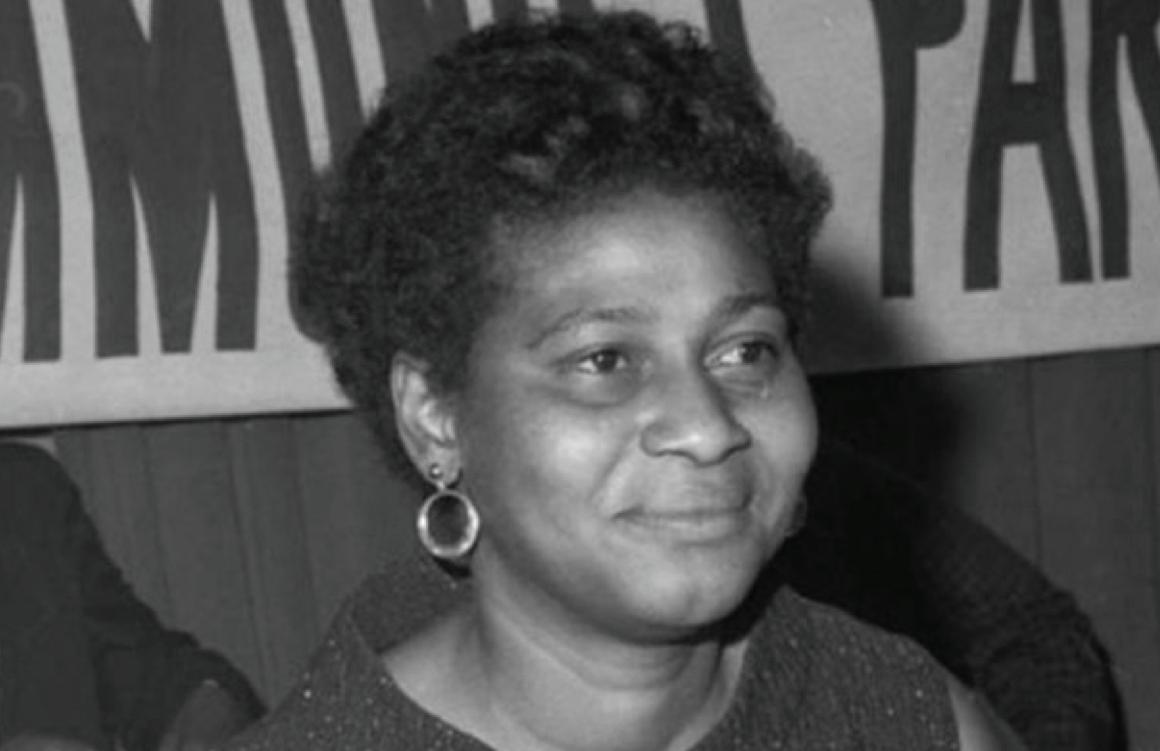
“Having known Charlene Mitchell through political victories and defeats, through personal tragedies and triumphs, I can say with confidence that she is the person to whom I am most grateful for showing me a life path,” activist Angela Davis, a professor at UC Santa Cruz, told the New York Times. Davis continued: “I don’t think I have ever known someone as consistent in her values, as collective in her outlook on life, as firm in her trajectory as a freedom fighter.”
In her 1968 run for president, Mitchell’s slogan was “Black and White Unite to Fight Racism, Poverty, and War!” She and her running mate made it to the ballot in only four states and won just over 1,000 votes, the New York Times reports, but her candidacy put a new face on the Communist Party, which was struggling under the weight of repression from the federal government.
Mitchell would eventually split from the Communist Party in the 1980s but would support several other anti-racist political organizations, including the Committees of Correspondence for Democracy and Socialism and the National Alliance Against Racial and Political Repression.
“Black Lives Matter and modern Black feminism stand on the shoulders of Charlene Mitchell,” Erik S. McDuffie, a professor of African American studies at the University of Illinois, told the New York Times.
postnewsgroup.com THE POST, December 28, 2022 - January 3, 2023, Page 10
Emil Guillermo
Richard Johnson (left) from Formerly Incarcerated Giving Back (FIGB) reached out to Jonathan Jones (right), from AASEG and Dr. Maritony-Yamot, an international community development technician, to respond to Oakland Post Publisher Paul Cobb’s challenge to “just serve our community by doing what’s needed for those in need.” Photo courtesy of Richard Johnson.
Charlene Mitchell. Wikipedia image.
By Angela Johnson
The city of Roanoke, Va., is honoring a Black woman who
Took
What
So Long?
Will Replace Robert E. Lee
page.
the
story on postnewsgroup.com
Henrietta Lacks: City of Roanoke Facebook
Read
full










 By Paul and Gay Plair Cobb
By Paul and Gay Plair Cobb





































 Edited by Lyzette Wanzer | c.2023, Lawrence Hill Books $19.99 255 pages
Edited by Lyzette Wanzer | c.2023, Lawrence Hill Books $19.99 255 pages

























